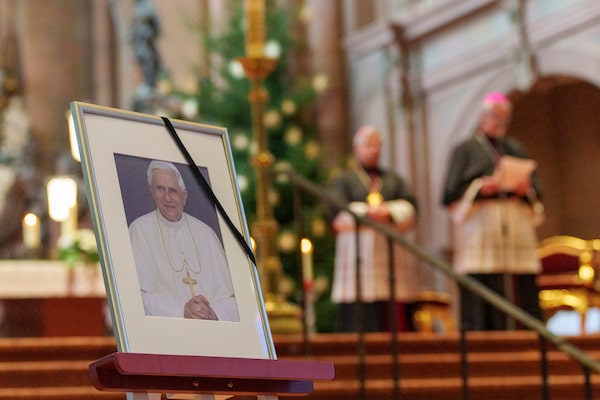
Clergy stay next to a portrait of Pope Emeritus Benedict XVI at Mainz Cathedral in Mainz, Germany, Saturday, Dec. 31, 2022. Pope Emeritus Benedict XVI, the German theologian who will be remembered as the first pope in 600 years to resign, has died, the Vatican announced Saturday. He was 95.Andreas Arnold/The Associated Press
Michael W. Higgins is Basilian Distinguished Fellow of Contemporary Catholic Thought at the University of Toronto’s St. Michael’s College, the former chief consultant for Sir Peter Ustinov’s Inside the Vatican, the co-author of Power and Peril: The Catholic Church at the Crossroads, and an award-winning biographer.
It is not surprising that Pope Emeritus Benedict XVI – the former cardinal born Joseph Ratzinger who passed away on Saturday at the age of 95 – has requested to be buried where St. John Paul II was interred in the Vatican. Although the two were unlike in temperament and aesthetic sensibility – Karol Wojtyla’s preference was for rousing Slavic folksongs, whereas Cardinal Ratzinger relished a Mozart piano concerto – they both worked in tandem to address a world they saw enmired in dangerous thinking, doctrinally unmoored, spiritually adrift.
No surprise, then, that John Paul II chose Cardinal Ratzinger as his papacy’s theological heavyweight, plucking him from the Archdiocese of Munich in 1981 and bringing him to Rome as prefect to run the Suprema (then known as the Congregation for the Doctrine of the Faith), the Vatican department that ensures orthodoxy. An accomplished theologian with an impressive pedigree, Cardinal Ratzinger did not hesitate to enforce on the ground what John Paul II vigorously proclaimed on his universal platform. Whereas John Paul’s vision was epic in scope and dramatic in style, as befits an actor and poet, his number two’s approach was meticulous, specific, forensic.
Obituary: The final exit of Benedict XVI
Pope Emeritus Benedict XVI will be remembered as conservative academic more than dynamic leader
The cardinal didn’t hesitate to admonish Catholic thinkers he felt were wayward, prone to celebrity, insufficient in their love for the church and reckless in disturbing the faithful. As a consequence, many of the most fertile and engaged theological minds in Catholicism were censored, silenced or expelled from religious life. Neither the pontiff nor his prefect would have seen this as a purge; rather, they saw this as the “righting” of Peter’s barque after the turbulence of modernity and the perceived flabbiness of institutional governance that followed the Second Vatican Council, between 1962 and 1965.
In many areas of Catholic thought, they were of similar mind and worked conjointly. Few, however, envisioned that the German prelate would succeed the Polish pontiff when he died in 2005. But if the cardinal electors wanted continuity at all costs, the choice was obvious: Cardinal Ratzinger knew the mind of John Paul II better than anyone else in the Vatican.
Appropriately, given the cardinal’s abhorrence of Western civilization’s drift from religious authority, he chose the name Benedict, after the great monastic thinker and founder who helped shape the future of Christianity out of the ruins of empire and the assaults of barbarism. And like his predecessor Benedict XV, whose papacy spanned the First World War, he would rebuild Christian Europe out of the universal carnage.
But almost from the outset, the new pope was embroiled in controversy. His address to an academic audience at the University of Regensburg whipped up an international storm resulting in estrangement from the Muslim community (although he was able to go some way to repairing the damage). He bungled his attempts at rapprochement with a schismatic group, the Society of St. Pius X, when he re-admitted various dissenting figures without appropriate scrutiny, failing to excise a notorious antisemite from their number. The Vati-Leaks scandal broke, implicating the Vatican in all kinds of sexual chicanery and venality. The German episcopate relentlessly opposed his leadership. And the clerical sex abuse scandal, with its endless disclosures of leadership complicity, worsened while he was pope.
But there were high points as well, including his remarkable trip to Great Britain when he beatified the Victorian thinker John Henry Newman, spoke at Westminster Abbey, drank orange Fanta with Queen Elizabeth, and surprised this most secular of countries with his charm and intelligence. (His public speeches were typically deadly in their lack of theatre and emotion but remarkable in their intellectual architecture.) A scholar’s scholar, he also produced a handful of uniformly penetrative encyclicals.
Indeed, Benedict XVI remained the old-school academic. Although the quality of his work was variable, books such as Introduction to Christianity and Principles of Catholic Theology are classics in their field. Throughout his life he was a major shaper of Catholic thought, a definer of the Catholic sensibility.
David Gibson, a sympathetic but critical biographer, rightly notes that “he was a pontiff who wanted to be a bridge but he wound up as a wedge.” I believe that this, ultimately, was the principal reason behind Benedict XVI’s unexpected resignation in 2013. He was certainly tired, as he said, his energy sapped by factionalism in the Vatican, his health fragile, his leadership diminished. But he also knew that the pontifex maximus had become an obstacle.
That was his first exit, when he became Pope Emeritus. And now we have his second. Requiescat in pace.